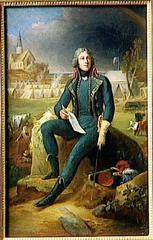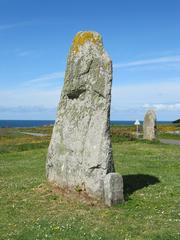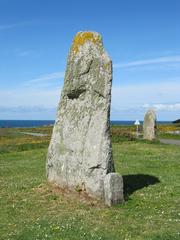Lazare Hoche Quiberon Visiting Hours, Tickets, and Historical Site Guide
Date: 03/07/2025
Introduction
Nestled along the southern coast of Brittany, France, the Quiberon Peninsula is renowned for its dramatic natural scenery and deep historical roots. At the heart of its heritage stands General Lazare Hoche, a pivotal figure of the French Revolution whose military leadership shaped the destiny of the region. Today, Quiberon invites visitors to explore monuments and sites commemorating Hoche’s legacy, including Fort Penthièvre and the evocative Monument to Lazare Hoche in the Varquès gardens.
This guide delivers in-depth information for exploring these key locations—from historical context to visitor logistics, including opening hours, ticketing, accessibility, and travel tips. Whether your interests lie in revolutionary history, scenic coastal walks, or local culture, Quiberon’s Lazare Hoche landmarks promise a rewarding experience. For the latest updates and further insights, consult resources such as the Official Quiberon Tourism website, the Petit Palais, and historical analyses (Emerson Kent).
Table of Contents
- Introduction
- Historical Background: Lazare Hoche and the Quiberon Campaign
- Fort Penthièvre and Quiberon Historical Sites
- Practical Travel Tips for Visiting Quiberon Peninsula
- Monument to Lazare Hoche in Quiberon
- Monument au Général Lazare Hoche in Quiberon
- General Lazare Hoche Monument in Quiberon
- FAQ
- Conclusion and Call to Action
- References and Further Reading
Quiberon Peninsula: History, Lazare Hoche, Fort Penthièvre, and Visitor Information
Historical Background: Lazare Hoche and the Quiberon Campaign
Lazare Hoche (1768–1797) emerged from humble origins to become a celebrated general of the French Revolution. His reputation was forged through his suppression of Royalist uprisings in western France, particularly during the War in the Vendée and the Chouannerie. His most famous victory was at the 1795 Quiberon Expedition, where he decisively thwarted a Royalist attempt to reclaim Brittany, ensuring Republican control and regional stability.
Fort Penthièvre
Visiting Hours:
Fort Penthièvre remains an active military site with partial public access from April to October, usually from 10:00 AM to 6:00 PM. Confirm hours through Quiberon Tourism for seasonal changes.
Tickets:
General access to public areas is free. Guided tours, offered during peak season, may require advance reservation and a small fee.
Accessibility:
Some areas are wheelchair accessible, though historic features mean some uneven terrain or steps.
Guided Tours:
Guided tours offer in-depth exploration of the 1795 battle and the fort’s history. Booking is recommended, especially in high season.
Lazare Hoche Statue and Memorials
The prominent statue of Lazare Hoche in central Quiberon is a focal point for visitors exploring his legacy. Nearby, the Cross of Lorraine at Fort Penthièvre honors those who fought during the campaign.
Practical Travel Tips for Quiberon Peninsula
- Getting There: Quiberon is accessible by car via the isthmus from mainland Brittany, with ample parking in town. Seasonal trains and local buses also connect Quiberon with surrounding cities.
- Ferry Services: Quiberon port offers ferries to islands like Belle-Île.
- Best Time to Visit: May to September offers optimal weather and full access to sites.
- Nearby Attractions: The Côte Sauvage coastline, Maison du Patrimoine museum, and local markets enhance any visit.
Monument to Lazare Hoche in Quiberon
Historical Background
The Monument to Lazare Hoche commemorates the general’s pivotal role during the French Revolution, particularly the 1795 defeat of Royalist forces at Quiberon. Conceived in 1895 and completed by Aimé-Jules Dalou (with Camille Lefèvre finishing after Dalou’s death), the monument was inaugurated in 1902. Its placement in the Varquès gardens was intended as a counterbalance to a nearby chapel commemorating Royalist émigrés, reflecting the ongoing contestation of revolutionary memory (Petit Palais).
Artistic Features and Symbolism
Dalou’s bronze statue, cast using the lost-wax technique, stands over 70 cm tall (not including pedestal) and is marked by the Hébrard foundry’s hallmark. Rather than depicting Hoche as a triumphant general, the sculpture shows him contemplative and somber, embodying the moral weight of victory and the ideals of the Republic (Petit Palais).
Historical Significance
The monument is both a work of art and a symbol of Republican values, commemorating Hoche’s efforts to stabilize Brittany and reconcile former enemies. Its erection in response to the Royalist chapel underscores the region’s divided memory of the Revolution.
Location and Setting
Located in Quiberon’s Varquès gardens, the monument is centrally situated and easily accessible. The surrounding park offers benches, mature trees, and tranquil paths for reflection.
Visitor Information
- Visiting Hours & Tickets: The Varquès gardens, and thus the monument, are open daily from early morning to dusk and are free to access.
- Accessibility: Paved, wheelchair-friendly paths lead to the monument. Public restrooms are nearby.
- Getting There: Quiberon is accessible by train from Auray (with a shuttle in summer) or by car. Parking is available in the town center.
- Best Time to Visit: Spring and early autumn offer pleasant weather and fewer crowds. Early morning and late afternoon are best for photography.
- Nearby Attractions: Pointe de Quiberon, Maison du Patrimoine, local beaches, and the Royalist chapel.
- Guided Tours: Included in broader walking tours—check with the tourist office for schedules. See also the Petit Palais for more on the statue’s history.
Cultural Insights
Commemorative events are held on Bastille Day and other holidays. The site’s proximity to the Royalist émigré chapel highlights the complexities of local history.
Monument au Général Lazare Hoche: Hours, Tickets, and Historical Sites Guide
Location and Accessibility
Situated in a central public square (Place Hoche) in Quiberon, the monument is easily reached by foot, car, or public transport. The seasonal ‘Tire-Bouchon’ train from Auray connects with the SNCF network, and the site is a short walk from Quiberon’s train station (France This Way).
Visiting Hours and Tickets
As an outdoor monument, it is accessible 24/7 with no admission or tickets needed. For the best experience, visit during daylight.
Historical Features
The statue, erected in 1902, was crafted by Aimé Jules Dalou and stands as a tribute to Hoche’s leadership during the 1795 Quiberon battle.
Practical Tips
- Best Times to Visit: June–September is peak season; early mornings and late afternoons are ideal for fewer crowds and better light.
- Accessibility: The monument is on flat, paved ground and accessible to all.
- Amenities: Public restrooms, cafés, and the Quiberon tourist office are nearby.
Visitor Experience and Etiquette
Photography is encouraged, especially during commemorations. While no dedicated tours exist, the monument is included in many historic walking tours.
Nearby Attractions
- Quiberon beaches
- Carnac standing stones (12 km away)
- La Trinité-sur-Mer harbor (13 km)
- Belle-Île-en-Mer (via ferry)
Safety and Local Customs
Quiberon is generally safe. Basic French greetings are appreciated, and respectful silence is customary during ceremonies.
Market Days
Experience Quiberon’s Saturday and seasonal Wednesday markets near the monument for local culture and crafts (France This Way).
General Lazare Hoche Monument: Historical Legacy and Visiting Information
The Quiberon Expedition of 1795
In June 1795, a Royalist army landed at Quiberon Bay aiming to restore the monarchy (Emerson Kent). General Hoche’s leadership was crucial in the Republican victory at Fort Penthièvre, quelling the counter-revolutionary threat (Napoleon Series).
General Hoche: Life and Significance
Born in 1768, Hoche’s meteoric rise and clemency after victory left a lasting legacy as a unifier who stabilized Brittany.
Artistic and Cultural Highlights
Dalou’s bronze statue (1902) stands atop a granite pedestal in Place Hoche, symbolizing Republican values. The monument is protected as a historic object (pop.culture.gouv.fr).
Visiting Information
- Location: Place Hoche, central Quiberon
- Hours: Outdoor, free access year-round
- Accessibility: Flat, pedestrian-friendly area
- Nearby Sites: Fort Penthièvre, Maison du Patrimoine, Musée de la Mer
- Tours: Available seasonally—check at the tourist office
Quiberon Peninsula: A Landscape Steeped in History
The peninsula’s dramatic coastline and sites like Fort Penthièvre are reminders of its Revolutionary past (Emerson Kent; cityzeum.com).
Commemoration and Local Identity
Annual commemorations and cultural events keep Hoche’s memory alive, with the monument serving as a site of reflection and education.
Frequently Asked Questions (FAQ)
Q: Are there entrance fees for any of the monuments?
A: No, all major Hoche monuments are free to access.
Q: When is the best time to visit?
A: May to September for optimal weather; early or late in the day for the best light.
Q: Is the area accessible for those with disabilities?
A: Yes, monuments and surrounding areas are designed for accessibility.
Q: Are guided tours available?
A: Yes, especially in summer—check with the local tourist office.
Q: What else should I see nearby?
A: Fort Penthièvre, Maison du Patrimoine, the beaches, Carnac, and Belle-Île-en-Mer.
Conclusion and Call to Action
The Lazare Hoche monuments and historical sites in Quiberon offer a profound encounter with French Revolutionary history in a breathtaking coastal setting. With free, year-round access and a wealth of nearby attractions, Quiberon is ideal for history enthusiasts and travelers alike.
Plan your visit with up-to-date information from official sources such as Quiberon Tourism and enhance your experience with the Audiala app for audio guides and interactive maps. Stay connected via social media for event announcements and local tips.
Embark on your journey to Quiberon—where the spirit of Lazare Hoche and the legacy of the Revolution live on amidst the beauty of Brittany.


